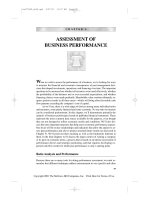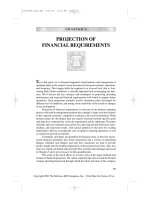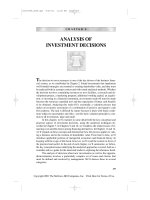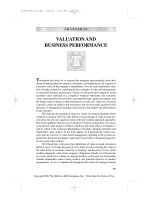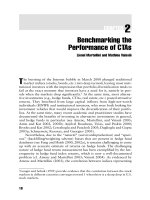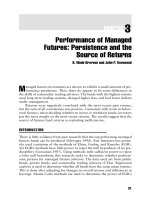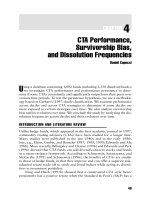Commodity Trading Advisors: Risk, Performance Analysis, and Selection Chapter 15 pps
Bạn đang xem bản rút gọn của tài liệu. Xem và tải ngay bản đầy đủ của tài liệu tại đây (262.4 KB, 19 trang )
PART
Four
Program Evaluation,
Selection, and Returns
Chapter 15 discusses the issues involved in setting up a commodity futures
trading program from start to finish. The chapter covers these areas that a
new entrant into the futures markets must consider: trade discovery, trade
construction, portfolio construction, risk management, leverage-level deter-
mination, and how the trading program will make a unique contribution to
an investor’s overall portfolio.
Chapter 16 analyzes the ex-post performance of CTA managed funds
with a higher moment-based, contingent-claim replication method. The per-
formance of each managed futures fund is compared to individually created
benchmark assets having the same risk profile in terms of particular higher
moments. Benchmark assets are constructed using the S&P 500, options, and
the risk-free asset. Using these benchmark assets, the author estimates the effi-
ciency gain or loss each CTA produces and analyzes the robustness of this
kind of efficiency measurement with respect to the number of moments used.
Chapter 17 aims at providing an overview of the industry and to quan-
tify its added value when included in portfolios (mean/variance optimiza-
tion). Different statistics and asset allocations studies are displayed within
a fixed or dynamic framework. A dynamic framework takes into account
time evolutions. On the asset allocation side, it then implies working in a
three-dimensional environment (mean/variance/time framework) and deal-
ing with efficient surfaces rather than efficient frontiers.
Chapter 18 examines whether CTA percent changes in NAVs follow ran-
dom walks. Monthly data from January 1994 to December 2000 are tested
275
c15_gregoriou.qxd 7/27/04 11:34 AM Page 275
276 PROGRAM EVALUATION, SELECTION, AND RETURNS
for nonstationarity and random walk with drift, using the Augmented Dickey-
Fuller test. All classifications (except the diversified subindex) are found to
behave as random walks, but many of the series show evidence of a positive
drift parameter, an indication that trends could be present in the series. The
effectiveness of CTAs in enhancing risk-return characteristics of portfolios
could be compromised when pure random walk behavior is identified.
Chapter 19 examines the risk and performance characteristics of dif-
ferent strategies involving the trading of commodity futures, financial
futures, and options on futures used by CTAs. The authors rank the returns
of the S&P 500 and MSCI Global Indices from the worst to the best
months, and partition the sample into 10 deciles. For each decile, they com-
pute the relationship between the CTA indices and the equity indices, and
compared their risk and return characteristics.
Chapter 20 analyzes the risk and return benefits of CTAs, as an alter-
native investment class. Then it shows, using a modified Value at Risk as a
more precise measure of risk, how CTAs can be integrated into existing
investment strategies and how we can determine the optimal proportion of
assets to invest in such products. Overall, the results of the study show that
an efficiently allocated portfolio consisting of CTA and traditional assets
should provide a better reward/risk ratio than an investment in traditional
assets only.
Chapter 21 uses time series processes to model the return series of the
10 largest CTAs from 1996 to 2003. Series are tested for stationarity, and
an appropriate ARMA model is applied to each CTA. The authors conduct
a similar analysis on the excess returns—relative to the CISDM CTA Index.
Last, stability tests are performed—through a Chow test—to investigate
possible structural changes in the parameters of the ARMA models.
Chapter 22 investigates the risk-adjusted returns of CTAs using the
modified Sharpe ratio. Because of the nonnormal returns of this asset class,
the traditional Sharpe ratio may not be appropriate. The CTAs are divided
into three categories in terms of ending millions under management.
Chapter 23 examines one of the most important features of managed
futures, their trend-following nature. This topic has been extensively
exploited to justify the inclusion of managed futures in traditional portfo-
lios, where they act as risk diversifiers during bear markets. However, man-
aged futures still may be risky over short-term horizons. How long does one
have to invest so that it is virtually certain a managed futures portfolio will
do better than cash or bonds? To answer this question, the authors exam-
ined monthly holding periods of the CSFB Tremont Managed Futures
Index. Their conclusion is that although managed futures are relatively safe
in the long run from a capital preservation perspective, their shortfall risk
remains and should not be neglected.
c15_gregoriou.qxd 7/27/04 11:34 AM Page 276
CHAPTER
15
How to Design a Commodity
Futures Trading Program
Hilary Till and Joseph Eagleeye
W
e provide a step-by-step primer on how to design a commodity futures
trading program. A prospective commodity manager not only must
discover trading strategies that are expected to be generally profitable, but
also must be careful regarding each strategy’s correlation properties during
different times of the year and during eventful periods. He or she also must
ensure that the resulting product has a unique enough return stream that it
can be expected to provide diversification benefits to an investor’s overall
portfolio.
INTRODUCTION
When designing a commodity futures trading program, a commodity man-
ager needs to create an investment process that addresses these issues:
■ Trade discovery
■ Trade construction
■ Portfolio construction
■ Risk management
■ Leverage level
■ How the program will make a unique contribution to the investor’s
overall portfolio
This chapter covers each of these subjects in succession.
TRADE DISCOVERY
The first step is to discover a number of trades in which it is plausible that
the investor has an “edge,” or advantage. Although a number of futures
277
c15_gregoriou.qxd 7/27/04 11:34 AM Page 277
trading strategies are well known and publicized, commodity managers
continue to apply them. Three examples of such strategies follow.
Grain Example
In discussing consistently profitable grain futures trades, Cootner (1967)
stated that the fact that they “persist in the face of such knowledge indi-
cates that the risks involved in taking advantage of them outweigh the gain
involved. This is further evidence that [commercial participants do] not
act on the basis of expected values; that [these participants are] willing
to pay premiums to avoid risk” (page 98). Cootner’s article discussed
detectable periods of concentrated hedging pressure by agricultural market
participants that lead to “the existence of predictable trends in future
prices.” It provided several empirical examples of this occurrence, includ-
ing “the effect of occasional long hedging in the July wheat contract.”
Noting the tendency of the prices of futures contracts to “fall on average
after the peak of net long hedging,” Cootner stated that the July wheat
contract should “decline relative to contract months later in the crop year
which are less likely to be marked by long hedging.” Table 15.1 summa-
rizes Cootner’s empirical study on a wheat futures spread. The spread on
average declined by about 2.5 cents over the period. The significant issue
for us is that this phenomenon, which is linked to hedging activity, was
published in 1967. Does this price pressure effect still exist today? The
short answer appears to be yes.
From 1979 to 2003, on average, this spread declined by 3.8 cents with
a Z-statistic of −3.01. Figure 15.1 illustrates the yearly performance of this
spread.
278 PROGRAM EVALUATION, SELECTION, AND RETURNS
TABLE 15.1 Cootner’s Empirical Study on the July versus December
Wheat Futures Spread
1948 to 1966 Average of July Versus December
Wheat Futures Price on the Indicated Dates
January 31 −5.10 cents
February 28 −5.35 cents
March 31 −5.62 cents
April 30 −5.69 cents
May 31 −6.55 cents
June 30 −7.55 cents
Source: Paul Cootner, “Speculation and Hedging.” Food Research
Institute Studies, Supplement 7, (1967): 100.
c15_gregoriou.qxd 7/27/04 11:34 AM Page 278
This trade is obviously not riskless. To profit from this trade, a man-
ager generally would short the spread, so it is the positive numbers in
Figure 15.1 that would represent losses. Note from the figure the magni-
tude of potential losses that this trade has incurred over the past 25 years.
That said, Cootner’s original point that a profitable trade can persist in the
face of knowledge of its existence seems to be borne out 36 years later.
Figure 15.2 summarizes the information in Figure 15.1 differently to
emphasize the “tail risk” of a July to December wheat spread strategy. If a
manager took a short position in this spread, the possible outcomes incor-
porate losses that are several times the size of the average profit. Again, in
a short position, the manager wants the price change to be negative, so the
historical losses on this trade are represented by the positive numbers in Fig-
ure 15.2. A manager might conclude that this trade can continue to exist
How to Design a Commodity Futures Trading Program 279
July Wheat–December Wheat Price Change from January 31 to
June 30, 1979–2003
–15
–10
–5
0
5
10
15
1979
1981
1983
1985
1987
1989
1991
1993
1995
1997
1999
2001
2003
Year
Price Change in Cents
per Bushel
FIGURE 15.1 Cootner’s Example Out of Sample
Source: Premia Capital Management, LLC.
0
2
4
6
8
10
12
14
≤ –14.25c
> –14.25c and ≤ –8.5c
> –8.5c and ≤ -2.75c > –2.75c and ≤ 3c > 3c and ≤ 8.75c > 8.75c
Price Change Intervals
Frequency
FIGURE 15.2 Histogram of the Frequency Distribution for the July
Wheat–December Wheat Price Changes, 1979–2003
Source: Premia Capital Management, LLC.
c15_gregoriou.qxd 7/27/04 11:34 AM Page 279
because of the unpleasant tail risk that must be assumed when putting on
this trade.
Petroleum Complex Example
Are there any persistent price tendencies that can be linked to structural
aspects of the petroleum market? After examining the activity of commer-
cial participants in the petroleum futures markets, it appears that their
hedging activity is bunched up within certain time frames. These same time
frames also seem to have detectable price trends, reflecting this commercial
hedging pressure.
Like other commodities, the consumption and production of petroleum
products are concentrated during certain times of the year, as illustrated in
Figure 15.3. This is the underlying reason why commercial hedging pres-
sure also is highly concentrated during certain times of the year.
The predictable price trends that result from concentrated hedge pres-
sure may be thought of as a type of premium the commercial market partic-
ipants are willing to pay. That commercial participants will engage in hedging
during predictable time frames and thus will pay a premium to do so may be
compared to individuals willing to pay higher hotel costs to visit popular
locations during high season. They are paying for this timing convenience.
280 PROGRAM EVALUATION, SELECTION, AND RETURNS
−0.05
0
0.05
Jan Feb Mar Apr May Jun Jul Aug Sep Oct Nov Dec
Sales
Production
FIGURE 15.3 Petroleum Seasonal Sales and Production Patterns
Source: Jeffrey Miron, The Economics of Seasonal Cycles (Cambridge, MA:
MIT Press, 1996), p. 118.
Note: The seasonal coefficient plotted for each month is the average percentage
difference for that month from a logarithmic time trend.
c15_gregoriou.qxd 7/27/04 11:34 AM Page 280
Corn Example
Corn provides another example of a persistent price pressure effect. The
futures prices of some commodity contracts, including corn, sometimes
embed a fear premium due to upcoming, meaningful weather events.
According to a Refco (2000) commentary: “The grain markets will always
assume the worst when it comes to real or perceived threats to the food sup-
ply” (page 1). As a result, coming into the U.S. growing season, grain
futures prices seem to systematically have a premium added into the fair
value price of the contract. The fact that this premium can be easily washed
out if no adverse weather occurs is well known by the trade. Notes a
Salomon Smith Barney (2000) commentary: “The bottom line is: any threat
of ridging this summer will spur concerns of yield penalties. That means
the market is likely to keep some ‘weather premium’ built into the price of
key markets. The higher the markets go near term, the more risk there will
be to the downside if and when good rains fall” (page 1). By the end of
July, the weather conditions that are critical for corn yield prospects will
have already occurred. At that point, if weather conditions have not been
adverse, the weather premium in corn futures prices will no longer be
needed. According to the Pool Commodity Trading Service (1999): “In any
weather market there remains the potential for a shift in weather forecasts
to immediately shift trends, but it appears as though grains are headed for
further losses before the end of the week. With 75% of the corn silking, the
market can begin to get comfortable taking some weather premium out”
(page 1). Again, this example shows that the commercial trade can be well
aware of a commodity futures price reflecting a biased estimate of future
valuation, and yet the effect still persisting.
TRADE CONSTRUCTION
Experience in commodity futures trading shows that a trader can have a
correct commodity view, but how he or she constructs the trade to express
the view can make a large difference in profitability.
Outright futures contracts, options, or spreads on futures contracts can
be used to express a commodity view.
At times futures spreads are more analytically tractable than trading
outright. Usually some economic boundary constraint links related com-
modities, which can (but not always) limit the risk in position taking. Also,
a trader hedges out a lot of first-order, exogenous risk by trading spreads.
For example, with a heating oil versus crude oil futures spread, each leg of
the trade is equally affected by unpredictable OPEC shocks. Instead, what
How to Design a Commodity Futures Trading Program 281
c15_gregoriou.qxd 7/27/04 11:34 AM Page 281
typically affects the spread is second-order risk factors, such as timing
differences in inventory changes among the two commodities. It is some-
times easier to make predictions regarding these second-order risk factors
than the first-order ones.
PORTFOLIO CONSTRUCTION
Once an investor has discovered a set of trading strategies that are expected
to have positive returns over time, the next step is to combine the trades into
a portfolio of diversified strategies. The goal is to combine strategies that are
uncorrelated with each other to end up with a dampened-risk portfolio.
Diversification
Figure 15.4 illustrates a commodity futures portfolio from June 2000, which
combined hedge-pressure trades with weather-fear-premium trades. The fig-
ure shows the effect of incrementally adding unrelated trades on portfolio
volatility.
282 PROGRAM EVALUATION, SELECTION, AND RETURNS
6.0
7.0
8.0
9.0
10.0
11.0
12.0
13.0
14.0
1234567
Number of Strategies
Portfolio Volatility
FIGURE 15.4 Annualized Portfolio Volatility versus Number of Commodity
Investment Strategies, June 2000
Source: Hilary Till, “Passive Strategies in the Commodity Futures Markets,”
Derivatives Quarterly (2000), Exhibit 5.
Copyright © Institutional Investor, Inc.
c15_gregoriou.qxd 7/27/04 11:34 AM Page 282
Inadvertent Concentration Risk
A key concern for all types of leveraged investing is inadvertent concentra-
tion risk. In leveraged commodity futures investing, one must be careful with
commodity correlation properties. Seemingly unrelated commodity markets
can become temporarily highly correlated. This becomes problematic if a
commodity manager is designing a portfolio so that only a certain amount
of risk is allocated per strategy. The portfolio manager may be inadvertently
doubling up on risk if two strategies are unexpectedly correlated.
Figures 15.5 and 15.6 provide examples from the summer of 1999 that
show how seemingly unrelated markets can temporarily become quite
related.
Normally natural gas and corn prices are unrelated, as shown in Figure
15.5. But during July, they can become highly correlated. During a three-
week period in July 1999, the correlation between natural gas and corn
price changes was 0.85, as illustrated in Figure 15.6.
Both the July corn and natural gas futures contracts are heavily depend-
ent on the outcome of weather in the U.S. Midwest. And in July 1999, the
How to Design a Commodity Futures Trading Program 283
210
215
220
225
230
235
240
245
250
1.8 1.9 2 2.1 2.2 2.3 2.4 2.5
Natural Gas Futures Prices
Corn Futures Prices
FIGURE 15.5 September Corn Futures Prices versus September Natural Gas
Future Prices, November 30, 1998, to June 28, 1999
Source: Hilary Till, “Taking Full Advantage of the Statistical Properties of
Commodity Investments,” Journal of Alternative Investments (2001), Exhibit 3.
Note: Using a sampling period of every three days, the correlation of the percent
change in corn prices versus the percent change in natural gas prices is 0.12.
Copyright © Institutional Investor, Inc.
c15_gregoriou.qxd 7/27/04 11:34 AM Page 283
Midwest had blistering temperatures (which even led to some power out-
ages). During that time, both corn and natural gas futures prices responded
in nearly identical fashions to weather forecasts and realizations.
If a commodity portfolio manager had included both natural gas and
corn futures trades in a portfolio during this time frame, then that investor
would have inadvertently doubled up on risk.
In order to avoid inadvertent correlations, it is not enough to measure
historical correlations. Using the data in Figure 15.5, an investor would
have concluded that corn and natural gas price changes are only weakly
related. An investor needs, however, to have an economic understanding of
why a trade works in order to best be able to appreciate whether an addi-
tional trade will act as a portfolio diversifier. In that way, the investor will
avoid doubling up on the risks that Figure 15.6 illustrates.
RISK MANAGEMENT
The fourth step in designing a commodity futures trading program is risk
management, because the portfolio manager needs to ensure that during
284 PROGRAM EVALUATION, SELECTION, AND RETURNS
185
190
195
200
205
210
215
2.16 2.21 2.26 2.31 2.36 2.41
Natural Gas Futures Prices
Corn Futures Prices
FIGURE 15.6 September Corn Futures Prices versus September Natural
Gas Prices, June 29, 1999, to July 26, 1999
Source: Hilary Till, “Taking Full Advantage of the Statistical Properties of
Commodity Investments,” Journal of Alternative Investments (2000),
Exhibit 4.
Using a sampling period of every three days, the correlation of the
percent change in corn prices versus the percent change in natural gas
prices is 0.85.
Copyright © Institutional Investor, Inc.
c15_gregoriou.qxd 7/27/04 11:34 AM Page 284
both normal and eventful times, the program’s losses do not exceed a client’s
comfort level.
Risk Measures
On a per-strategy basis, it is useful to examine each strategy’s:
■ Value at risk based on recent volatilities and correlations
■ Worst-case loss during normal times
■ Worst-case loss during well-defined eventful periods
■ Incremental contribution to portfolio value at risk
■ Incremental contribution to worst-case portfolio event risk
The last two measures give an indication if the strategy is a risk reducer
or risk enhancer. On a portfolio-wide basis, it is useful to examine the
portfolio’s:
■ Value at risk based on recent volatilities and correlations
■ Worst-case loss during normal times
■ Worst-case loss during well-defined eventful periods
Each measure should be compared to some limit, which has been deter-
mined based on the design of the futures product. So, for example, if clients
expect the program to lose no more than, say, 7 percent from peak-to-
trough, then the three portfolio measures should be constrained to not
exceed 7 percent. If the product should not perform too poorly during, say,
financial shocks, then the worst-case loss during well-defined eventful peri-
ods should be constrained to a relatively small number. If that worst-case
loss exceeds the limit, then the manager can devise macro-portfolio hedges
accordingly, as will be discussed later.
For the purposes of extraordinary stress testing, we would recommend
examining how a portfolio would have performed during the four eventful
periods listed in Table 15.2.
How to Design a Commodity Futures Trading Program 285
TABLE 15.2 Meaningful Eventful Periods
October 1987 stock market crash
1990 Gulf War
Fall 1998 bond market debacle
Aftermath of 9/11/01 attacks
c15_gregoriou.qxd 7/27/04 11:34 AM Page 285
A commodity portfolio that would do poorly during these time frames
may be unacceptable to clients who are investing in a nontraditional invest-
ment for diversification benefits. Therefore, in addition to examining a
portfolio’s risk based on recent fluctuations using value at risk measures, a
manager also should examine how the portfolio would have performed
during the eventful times listed in Table 15.2.
Tables 15.3 and 15.4 provide examples of the recommended risk meas-
ures for a particular commodity futures portfolio. Note, for example, the
properties of the soybean crush spread. It is a portfolio event-risk reducer,
but it also adds to the volatility of the portfolio. An incremental contribu-
tion to risk measure based solely on recent volatilities and correlations does
not give complete enough information about whether a trade is a risk
reducer or risk enhancer.
Macro-Portfolio Hedging
Understanding a portfolio’s exposure to certain financial or economic
shocks can help in designing macro-portfolio hedges that would limit expo-
sure to these events. For example, a commodity portfolio from the summer
286 PROGRAM EVALUATION, SELECTION, AND RETURNS
TABLE 15.3 Strategy-Level Risk Measures
Worst-Case Loss Worst-Case Loss
during Normal during Eventful
Strategy Value at Risk Times Period
Deferred Reverse
Soybean Crush Spread 2.78% −1.09% −1.42%
Long Deferred
Natural Gas Outright 0.66% −0.18% −0.39%
Short Deferred
Wheat Spread 0.56% −0.80% −0.19%
Long Deferred
Gasoline Outright 2.16% −0.94% −0.95%
Long Deferred Gasoline
vs. Heating Oil Spread 2.15% −1.04% −2.22%
Long Deferred
Hog Spread 0.90% −1.21% −0.65%
Portfolio 3.01% −2.05% −2.90%
Source: Hilary Till, “Risk Management Lessons in Leveraged Commodity Futures
Trading,” Commodities Now (September 2002).
c15_gregoriou.qxd 7/27/04 11:34 AM Page 286
of 2002 consisted of these positions: outright long wheat, a long gasoline
calendar spread, and short outright silver. When carrying out an event-risk
analysis on the portfolio, one finds that the worst-case scenario was a
9/11/01 scenario. This is because the portfolio was long economically
sensitive commodities and short an instrument that does well during time
of flights to quality. Normally, though, these positions are unrelated to each
other. Given that the scenario that would most negatively impact the port-
folio was a sharp shock to business confidence, one candidate for macro-
portfolio insurance was short-term gasoline puts to hedge against this
scenario.
LEVERAGE LEVEL
Another consideration in designing a commodity futures program is how
much leverage to use. Futures trading requires a relatively small amount of
margin. Trade sizing is mainly a matter of how much risk one wants to
assume. An investor is not very constrained by the amount of initial capital
committed to trading.
How to Design a Commodity Futures Trading Program 287
TABLE 15.4 Portfolio-Effect Risk Measures
Incremental
Incremental Contribution to
Contribution to Worst-Case Portfolio
Strategy Portfolio Value at Risk
a
Event Risk
a
Deferred Reverse
Soybean Crush Spread 0.08% −0.24%
Long Deferred Natural
Gas Outright 0.17% 0.19%
Short Deferred
Wheat Spread 0.04% 0.02%
Long Deferred
Gasoline Outright 0.33% 0.81%
Long Deferred Gasoline vs.
Heating Oil Spread 0.93% 2.04%
Long Deferred Hog Spread 0.07% −0.19%
a
A positive contribution means that the strategy adds to risk while a negative con-
tribution means the strategy reduces risk.
Source: Hilary Till, “Risk Management Lessons in Leveraged Commodity Futures
Trading,” Commodities Now (September 2002).
c15_gregoriou.qxd 7/27/04 11:34 AM Page 287
What leverage level is chosen for a program is a product design issue.
The manager needs to determine how the program will be marketed and
what the client’s expectations will be.
According to Barclay Managed Funds Report (2001), a number of top
commodity trading advisors (CTAs) have had losses in excess of −40 per-
cent, which have been acceptable to their clients since these investment pro-
grams sometimes produce 100+ percent annual returns. Investors know up
front the sort of swings in profits and losses to expect from such managers.
Choosing the leverage level for a futures program is a crucial issue
because it appears that the edge that successful futures traders are able to
exploit is small. Only with leverage do their returns become attractive.
Table 15.5 shows how the returns to futures programs, here labeled “man-
aged futures,” become competitive only after applying the most amount of
leverage of any hedge fund strategy.
In Patel (2002), Bruce Cleland of Campbell and Company, a pioneer of
futures investing, discusses how essential leverage is to his firm’s success:
“Campbell’s long-term average rate of return compounded over 31 years is over
17.6 percent net [of fees]. No market-place is going to be so inefficient as
to allow any kind of systematic strategy to prevail over that period of time, to
288 PROGRAM EVALUATION, SELECTION, AND RETURNS
TABLE 15.5 Levered and Delevered Returns by Hedge Fund Strategy,
1997 to 2001
Style Average Levered Return (%)
a
Average Delevered Return (%)
a
Short Biased 13.7 9.3
Global Macro 16.8 8.9
Emerging Markets 16.9 8.8
Event Driven 14.7 8.3
Merger Aritrage 14.7 7.0
Long/Short Equity 14.0 6.3
Fixed income 9.6 4.8
Convertible Arbitrage 10.6 4.2
Managed Futures 10.5 4.2
Distressed Securities n/a n/a
a
Leverage analysis was done for funds with five-year historical leverage and per-
formance data.
Source: Altvest, CSFB/Tremont, EACM, HFR, Institutional Investor (June 2002),
and CMRA.
Leslie Rahl, “Hedge Fund Transparency: Unraveling the Complex and
Controversial Debate,” RiskInvest 2002, Boston, December 10, 2002, Slide 52.
c15_gregoriou.qxd 7/27/04 11:34 AM Page 288
that extent. ‘Our true edge is actually only around 4 percent per year, but
through leverage of between 4-1 and 5-1 you are able to get a much more
attractive return,’ Cleland says” (page 49). This quote from the president of
Campbell is very instructive for neophyte futures traders who must deter-
mine how much leverage to use in delivering their clients an attractive set of
returns.
UNIQUE CONTRIBUTION TO THE INVESTOR’S
OVERALL PORTFOLIO
A final consideration in creating a futures trading program is to understand
how the program will fit into an investor’s overall portfolio. For investors
to be interested in a new investment, that investment must have a unique
return stream: one that is not already obtained through their other invest-
ments. More formally, the new investment must be a diversifier, either dur-
ing normal times or eventful times.
It is up to investors to determine how a new investment should fit into
their portfolios. A futures trading program may be evaluated on how well
it diversifies an equity portfolio. Or it may be judged based on how well it
diversifies a basket of veteran CTAs. Finally, a new futures trading program
may be evaluated on how well it improves a fund of hedge fund’s risk-
adjusted returns. Examples of each kind of evaluation follow.
Equity Diversification Example
One potential commodity futures investment is based on the Goldman
Sachs Commodity Index (GSCI). One way to evaluate its potential benefits
for an international equity portfolio is to use a portfolio optimizer to cre-
ate the portfolio’s efficient frontier both with and without an investment in
the GSCI. Figure 15.7 from Satyanarayan and Varangis (1994) illustrates
this approach. The efficient frontier with commodity assets lies everywhere
higher than the portfolio without commodity assets, implying that for the
same levels of return (risk), the portfolio with commodity assets provides
lesser (higher) risk (return). This would be regarded as attractive provided
that the historical returns, volatilities, and correlations used in the opti-
mizer are expected to be representative of future results.
CTA Diversification Example
A futures program that invests solely in commodities has a natural advan-
tage in claiming diversification benefits for a portfolio of CTAs. As Table
How to Design a Commodity Futures Trading Program 289
c15_gregoriou.qxd 7/27/04 11:34 AM Page 289
290 PROGRAM EVALUATION, SELECTION, AND RETURNS
15.6 illustrates, an index of managed futures returns is most strongly
related to investment strategies focused on currencies, interest rates, and
stocks. Commodities are in fourth place.
One way of demonstrating that a commodity investment strategy is of
benefit to a diversified portfolio of CTAs is to calculate how the Sharpe
ratio (excess return divided by standard deviation) would change once the
new investment is added to the portfolio. Table 15.7 shows how the addi-
tion of a particular commodity manager to three diversified portfolios in-
creases the Sharpe ratio of each portfolio. The three diversified portfolios
are represented by CTA indices provided by Daniel B. Stark & Co.
Figure 15.8 illustrates another way of confirming that a futures trading
program would be a diversifier for an existing investment in a basket of
futures traders. Figure 15.8 shows that the Stark Diversified CTA index
alone has a Sharpe ratio of about 0.72. If 60 percent is allocated to the
Stark index and 40 percent to a specific advisor’s program, the Sharpe ratio
rises to 1.0 even though the specific advisor’s program alone has a Sharpe
ratio of below 1.0.
0
0.5
1
1.5
2
2.5
3
2.5 3 3.5 4 4.5 5 5.5 6
Monthly Standard Deviation
Expected Monthly Return
0.4
0.42
0.3
0.38
0.42
0.41
0.34
0.09
0.21
M
M
0.12
With GSCI
Without GSCI
FIGURE 15.7 Optimal International Portfolios with and without Commodity Assets
Source: Sudhakar Satyanarayan and Panos Varangis, “An Efficient Frontier for
International Portfolios with Commodity Assets,” Policy Research Working
Paper 1266, The World Bank, March 1994, p. 19.
Note: The numbers on the mean-standard deviation frontier refer to the percent-
age of the portfolio invested in commodity assets. M = minimum-risk portfolio.
c15_gregoriou.qxd 7/27/04 11:34 AM Page 290
Fund of Hedge Fund Diversification Example
Similarly, if the futures program is expected to be a diversifier for a fund of
hedge funds portfolio, whether the Sharpe ratio of the enhanced portfolio
improves as well must be verified. This is illustrated in Table 15.8.
How to Design a Commodity Futures Trading Program 291
TABLE 15.7 Example of How the Sharpe Ratio of CTA Indices Changes with the
Addition of a Particular Commodity Futures Program, September 1999 to March 2003
Index Alone With 10% GA
b
Component
Sharpe Sharpe
Index CARR
a
Vol % Ratio CARR Vol % Ratio
Stark Fund Index 6.80% 13.60% 0.50 7.80% 11.80% 0.66
Stark 300 CTA Index 8.70% 10.80% 0.80 9.40% 9.60% 0.98
Stark Diversified CTA 9.50% 11.60% 0.82 10.10% 10.30% 0.98
a
Compounded annualized rate of return
b
Global Advisors Discretionary Program, a futures trading program
Source: “The Case for Commodities,” Global Advisors (June 2003).
Copyright © Daniel B. Stark & Company.
TABLE 15.6 Regression of Managed Futures Returns on Passive Indices and
Economic Variables, 1996 to 2000
Coefficient Standard Error T-Statistic
Intercept 0.00 0.00 0.01
S&P 500 0.00 0.07 0.05
Lehman US 0.29 0.39 0.76
Change in Credit Spread 0.00 0.01 0.30
Change in Term Spread 0.00 0.00 0.18
MFSB/Interest Rates 1.27 0.24 5.24
MFSB/Currency 1.37 0.25 5.48
MFSB/Physical Commodities 0.27 0.15 1.79
MFSB/Stock Indices 0.36 0.11 3.17
R-Squared 0.70
Source: Center for International Securities and Derivatives Markets (CISDM), 2nd
Annual Chicago Research Conference, May 22, 2002. Slide 48.
Note: The Managed Futures Securities Based (MFSB) Indices are designed to mimic
the performance of CTAs who employ trend-following or countertrend strategies.
c15_gregoriou.qxd 7/27/04 11:34 AM Page 291
292 PROGRAM EVALUATION, SELECTION, AND RETURNS
0.70
0.75
0.80
0.85
0.90
0.95
1.00
1.05
1.10
1.15
0% 10% 20% 30% 40% 50% 60% 70% 80% 90% 100%
Stark 300 Index Allocation
Sharpe Ratio
FIGURE 15.8 Efficient Portfolio GALP
a
+ Stark Diversified CTA Index, September
1999 to March 2003
Source: “The Case for Commodities,” Global Advisors (June 2003), Chart 1.
a
Global Advisors LP.
Note: The vertical axis is the Sharpe ratio. The horizontal axis is the amount
allocated to the Stark Index; the balance is allocated to the GALP trading program.
Copyright © Daniel B. Stark & Company.
TABLE 15.8 Example of How the Sharpe Ratio of a Fund of Hedge Funds
Changes with the Addition of a Particular Commodity Futures Program,
September 1999 to March 2003
Index Alone With 10% GA
a
Component
Sharpe Sharpe
Index CARR
b
Vol% Ratio CARR Vol% Ratio
Model Fund of
Funds Portfolio
c
7.80% 5.00% 1.56 8.50% 5.00% 1.7
a
Global Advisors Discretionary Program, a futures trading program
b
Compounded annualized rate of return
c
The model fund of funds portfolio comprises Edhec Business School indices in the
following weights: 40 percent Long/Short Equity, 10 percent Convertible Arbitrage,
10 percent Global Macro, 10 percent Managed Futures, 5 percent Equity Market
Neutral, 5 percent Fixed Income Arbitrage, 5 percent Distressed Securities, 5 percent
Emerging Markets, 5 percent Merger Arbitrage, and 5 percent Event Driven.
Source: “The Case for Commodities,” Global Advisors (June 2003).
c15_gregoriou.qxd 7/27/04 11:34 AM Page 292
CONCLUSION
This chapter has outlined the considerations involved in creating a com-
modity futures trading program. Commodity managers need to be aware
that trading strategies can exhibit periods of high correlation, which can
lead to doubling risk. We showed that adding commodity futures to a port-
folio can potentially reduce overall portfolio risk. We also showed that
futures programs must employ leverage in order for their returns to be
competitive. To provide diversification benefits to investors, commodity
managers must produce return streams that are sufficiently unrelated to
those of other manager strategies as well as to traditional investments.
How to Design a Commodity Futures Trading Program 293
c15_gregoriou.qxd 7/27/04 11:34 AM Page 293

